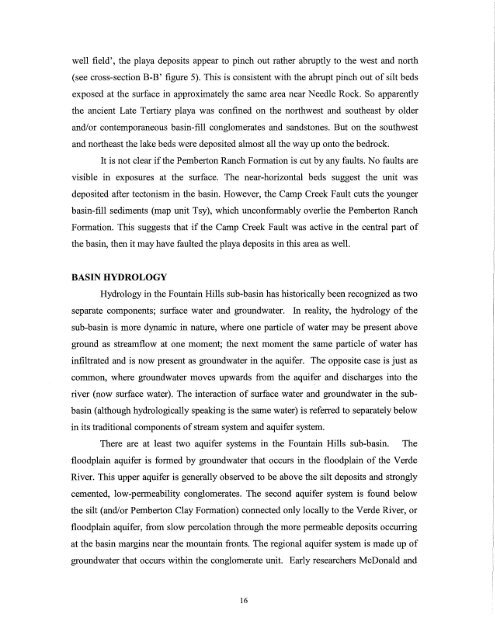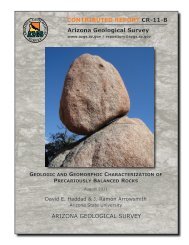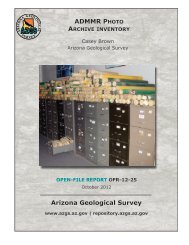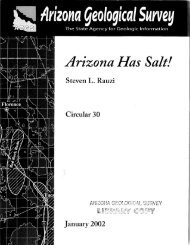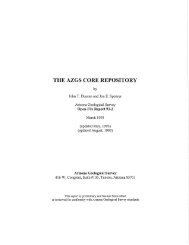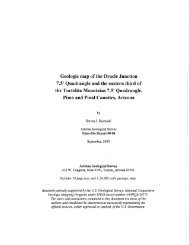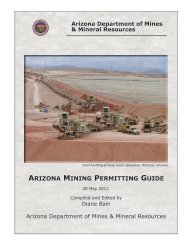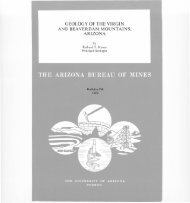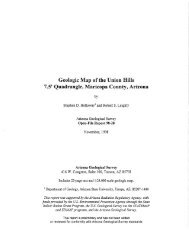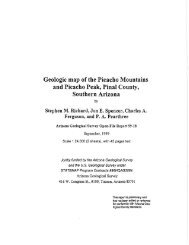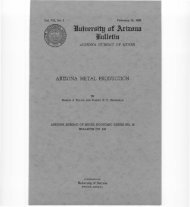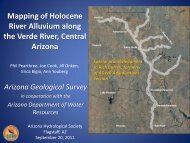Subsurface Geologic Investigation of Fountain Hills - AZGS ...
Subsurface Geologic Investigation of Fountain Hills - AZGS ...
Subsurface Geologic Investigation of Fountain Hills - AZGS ...
Create successful ePaper yourself
Turn your PDF publications into a flip-book with our unique Google optimized e-Paper software.
well field', the playa deposits appear to pinch out rather abruptly to the west and north<br />
(see cross-section B-B' figure 5). This is consistent with the abrupt pinch out <strong>of</strong> silt beds<br />
exposed at the surface in approximately the same area near Needle Rock. So apparently<br />
the ancient Late Tertiary playa was confined on the northwest and southeast by older<br />
and/or contemporaneous basin-fill conglomerates and sandstones. But on the southwest<br />
and northeast the lake beds were deposited almost all the way up onto the bedrock.<br />
It is not clear if the Pemberton Ranch Formation is cut by any faults. No faults are<br />
visible in exposures at the surface. The near-horizontal beds suggest the unit was<br />
deposited after tectonism in the basin. However, the Camp Creek Fault cuts the younger<br />
basin-fill sediments (map unit Tsy), which unconformably overlie the Pemberton Ranch<br />
Formation. This suggests that if the Camp Creek Fault was active in the central part <strong>of</strong><br />
the basin, then it may have faulted the playa deposits in this area as well.<br />
BASIN HYDROLOGY<br />
Hydrology in the <strong>Fountain</strong> <strong>Hills</strong> sub-basin has historically been recognized as two<br />
separate components; surface water and groundwater. In reality, the hydrology <strong>of</strong> the<br />
sub-basin is more dynamic in nature, where one particle <strong>of</strong> water may be present above<br />
ground as streamflow at one moment; the next moment the same particle <strong>of</strong> water has<br />
infiltrated and is now present as groundwater in the aquifer. The opposite case is just as<br />
common, where groundwater moves upwards from the aquifer and discharges into the<br />
river (now surface water). The interaction <strong>of</strong> surface water and groundwater in the sub<br />
basin (although hydrologically speaking is the same water) is referred to separately below<br />
in its traditional components <strong>of</strong> stream system and aquifer system.<br />
There are at least two aquifer systems in the <strong>Fountain</strong> <strong>Hills</strong> sub-basin. The<br />
floodplain aquifer is formed by groundwater that occurs in the floodplain <strong>of</strong> the Verde<br />
River. This upper aquifer is generally observed to be above the silt deposits and strongly<br />
cemented, low-permeability conglomerates. The second aquifer system is found below<br />
the silt (and/or Pemberton Clay Formation) connected only locally to the Verde River, or<br />
floodplain aquifer, from slow percolation through the more permeable deposits occurring<br />
at the basin margins near the mountain fronts. The regional aquifer system is made up <strong>of</strong><br />
groundwater that occurs within the conglomerate unit. Early researchers McDonald and<br />
16


